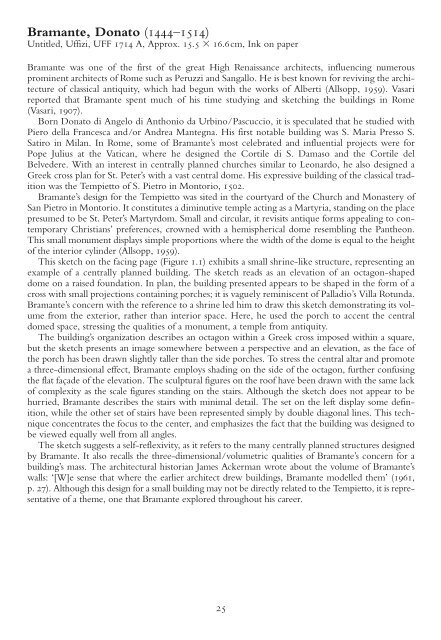Architect Drawings : A Selection of Sketches by World Famous Architects Through History
You also want an ePaper? Increase the reach of your titles
YUMPU automatically turns print PDFs into web optimized ePapers that Google loves.
Bramante, Donato (1444–1514)<br />
Untitled, Uffizi, UFF 1714 A, Approx. 15.5 16.6cm, Ink on paper<br />
Bramante was one <strong>of</strong> the first <strong>of</strong> the great High Renaissance architects, influencing numerous<br />
prominent architects <strong>of</strong> Rome such as Peruzzi and Sangallo. He is best known for reviving the architecture<br />
<strong>of</strong> classical antiquity, which had begun with the works <strong>of</strong> Alberti (Allsopp, 1959). Vasari<br />
reported that Bramante spent much <strong>of</strong> his time studying and sketching the buildings in Rome<br />
(Vasari, 1907).<br />
Born Donato di Angelo di Anthonio da Urbino/Pascuccio, it is speculated that he studied with<br />
Piero della Francesca and/or Andrea Mantegna. His first notable building was S. Maria Presso S.<br />
Satiro in Milan. In Rome, some <strong>of</strong> Bramante’s most celebrated and influential projects were for<br />
Pope Julius at the Vatican, where he designed the Cortile di S. Damaso and the Cortile del<br />
Belvedere. With an interest in centrally planned churches similar to Leonardo, he also designed a<br />
Greek cross plan for St. Peter’s with a vast central dome. His expressive building <strong>of</strong> the classical tradition<br />
was the Tempietto <strong>of</strong> S. Pietro in Montorio, 1502.<br />
Bramante’s design for the Tempietto was sited in the courtyard <strong>of</strong> the Church and Monastery <strong>of</strong><br />
San Pietro in Montorio. It constitutes a diminutive temple acting as a Martyria, standing on the place<br />
presumed to be St. Peter’s Martyrdom. Small and circular, it revisits antique forms appealing to contemporary<br />
Christians’ preferences, crowned with a hemispherical dome resembling the Pantheon.<br />
This small monument displays simple proportions where the width <strong>of</strong> the dome is equal to the height<br />
<strong>of</strong> the interior cylinder (Allsopp, 1959).<br />
This sketch on the facing page (Figure 1.1) exhibits a small shrine-like structure, representing an<br />
example <strong>of</strong> a centrally planned building. The sketch reads as an elevation <strong>of</strong> an octagon-shaped<br />
dome on a raised foundation. In plan, the building presented appears to be shaped in the form <strong>of</strong> a<br />
cross with small projections containing porches; it is vaguely reminiscent <strong>of</strong> Palladio’s Villa Rotunda.<br />
Bramante’s concern with the reference to a shrine led him to draw this sketch demonstrating its volume<br />
from the exterior, rather than interior space. Here, he used the porch to accent the central<br />
domed space, stressing the qualities <strong>of</strong> a monument, a temple from antiquity.<br />
The building’s organization describes an octagon within a Greek cross imposed within a square,<br />
but the sketch presents an image somewhere between a perspective and an elevation, as the face <strong>of</strong><br />
the porch has been drawn slightly taller than the side porches. To stress the central altar and promote<br />
a three-dimensional effect, Bramante employs shading on the side <strong>of</strong> the octagon, further confusing<br />
the flat façade <strong>of</strong> the elevation. The sculptural figures on the ro<strong>of</strong> have been drawn with the same lack<br />
<strong>of</strong> complexity as the scale figures standing on the stairs. Although the sketch does not appear to be<br />
hurried, Bramante describes the stairs with minimal detail. The set on the left display some definition,<br />
while the other set <strong>of</strong> stairs have been represented simply <strong>by</strong> double diagonal lines. This technique<br />
concentrates the focus to the center, and emphasizes the fact that the building was designed to<br />
be viewed equally well from all angles.<br />
The sketch suggests a self-reflexivity, as it refers to the many centrally planned structures designed<br />
<strong>by</strong> Bramante. It also recalls the three-dimensional/volumetric qualities <strong>of</strong> Bramante’s concern for a<br />
building’s mass. The architectural historian James Ackerman wrote about the volume <strong>of</strong> Bramante’s<br />
walls: ‘[W]e sense that where the earlier architect drew buildings, Bramante modelled them’ (1961,<br />
p. 27). Although this design for a small building may not be directly related to the Tempietto, it is representative<br />
<strong>of</strong> a theme, one that Bramante explored throughout his career.<br />
25




